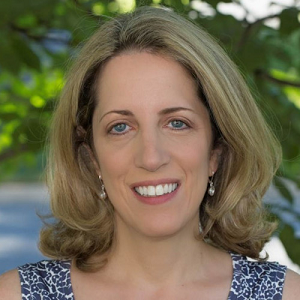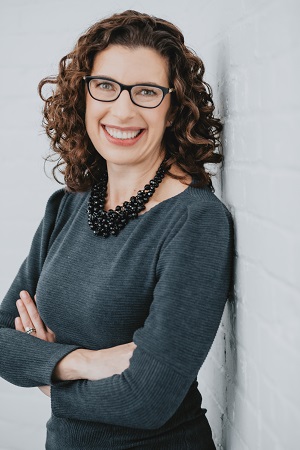 Beth Peshkin, MS, CGC |
 Megan Ranney, MPH, MD |
Live on-air interviews provide scientists with an opportunity to share their knowledge with the public and influence public opinion. However, many scientists experience anxiety when given the opportunity to share their research in live on-air interviews, so much so that they often turn down these invitations. Two seasoned experts and behavioral scientists share tips for participating in these interviews and ways to boost their confidence when appearing on live television to communicate their research.
Dr. Ranney is a practicing physician, researcher, and public advocate whose research focuses on digital health, violence prevention, and population health. She is the founding director of the Brown-Lifespan Center for Digital Health and the co-founder of the American Foundation for Firearm Injury Reduction in Medicine (AFFIRM) at the Aspen Institute. Her work and research have been featured on national and international media outlets, including the BBC, CNN, Fox News, the New York Times, and the Washington Post.
Ms. Peshkin is a professor of Oncology at Georgetown Comprehensive Cancer Center as well as the Education Director for the Jess and Mildred Fisher Center for Hereditary Cancer and Clinical Genomics Research. Ms. Peshkin has published over 140 peer-reviewed articles, and has given over 145 presentations to international, national, and local audiences.
1. Describe your research area/area of clinical practice.
Dr. Ranney: My research focuses on developing, testing, and disseminating digital health interventions to prevent violence and related behavioral health problems, as well as on COVID-related risk reduction.
Ms. Peshkin: My primary area of expertise is genetic counseling/testing for hereditary cancer, including research in family communication, service delivery/access to care, and psychological outcomes.
2. Please name some of the live media interviews you've given/on which networks or live shows you appeared.
Dr. Ranney:
- CNN/Situation Room with Wolf Blitzer
- CBS Sunday Morning with Jane Pauley
- PBS News Hour with Judy Woodruff
- In the Bubble with Andy Slavitt
- CNN/Kate Bolduan
- CNN Inside Politics
- MSNBC with Ari Melber
- MSNBC/Morning Joe
Ms. Peshkin:
- TV: PBS NewsHour, WJLA Channel 7, WUSA Channel 9, NBC 4 (all local network affiliates in Washington, DC). National network appearances were not live.
- NPR (radio): The Diane Rehm Show, All Things Considered, The Kojo Nnamdi Show, The 1a Show
3. What are your top 3 tips for live interviews?
Dr. Ranney:
- Have a great light and put plenty of powder on!
- Have 3 main points that you want to convey – and talk about them in terms that you would use when you go home and share with your neighbor or your family about what they need to know about this issue.
- Make sure you look at the camera if you're doing a remote interview! Don't look down at notes or, worse, look around the room.
Ms. Peshkin:
- Find out the topic of the interview in advance, including any specific areas of interest from the interviewer. Prepare at least 3 short sound bites in advance.
- Take control of the interview if needed – make sure you get your key point/s across even if you need to re-direct a question.
- Be compelling and brief – how you deliver your message can be as important as what you say. Answer the “so what” question in a persuasive way.
4. What have you done to make sure your position is clearly communicated or not misconstrued?
Dr. Ranney: Prepare, prepare, prepare – know your facts. Practice with a colleague if you need to. Be prepared with "bridges" if they ask a question that you don't want to answer (ways to pivot to the things that you actually want to talk about).
Ms. Peshkin: I try to keep my answers brief and to the point. If needed, I may reiterate my point by saying something like, “In other words…” or “I want to emphasize again….” I also try to repeat the question stem in my responses. Live interviews may be edited (e.g., for later broadcasts or on a website), so it helps keep my message clear and in context if the audience knows what question I am addressing.
5. Any tips for managing your nerves in a live interview?
Dr. Ranney: Know that you WILL feel nervous - that's normal! Practice deep breathing and pretend it's a friend.
Ms. Peshkin: Hydrate, a lot. You don’t want to have a dry mouth while being interviewed, which can happen when you’re nervous. Remember, you’re the expert. Dress comfortably and sit or stand up straight. Breathe. You got this.
6. How long was it from someone initially reaching out to you about the interview until the filming/recording?
Dr. Ranney: It’s often very fast – news happens, and journalists and TV bookers often seek reactions almost immediately.
7. How long was the live interview, or if you have done many, what has the range been?
Dr. Ranney: They’re often very short – hence the reason it’s so important to have short, easy-to-share bullet points of your main ideas and points. Two to three minutes can be a typical TV segment. Once you do those, you may then be invited for longer segments – they take more preparation but also allow for more nuance and conversation.
Ms. Peshkin: Usually, interviews are only a few minutes if they are on breaking news (but it may feel like an eternity), and it’s for a national or local news show. But for longer formats and when other people are being interviewed with me, some interviews have been 15-30 minutes (e.g., PBS NewsHour and the radio shows).
8. What other advice would you give to someone considering giving a live interview about their science?
Dr. Ranney: Be sure that you’re describing your work in ways that the general public can understand. You won’t be invited back if you go on and speak in such high level scientific terms that ordinary people have trouble following you. Remember that the audience for live media interviews is the general public. While that may include scientists and doctors who understand your work at the scientific level, it also includes plenty of people who need to hear your message but not speak your “language.”
Ms. Peshkin: Avoid jargon. Get right to the point. Anticipate difficult questions/areas of controversy and prepare short sound bites in advance. Understand who the audience is and tailor your responses accordingly. Once you have a microphone on, assume it is always on – don’t do any chit-chat while waiting. Avoid fillers such as “um,” “ah,” and “like.” Speak slowly. Ask the interviewer before you go live where you should look – at them or the camera. Finally, ask people from your Communications office for assistance or tips. They may also be willing to accompany you to your interview to give you advice and calm your nerves.